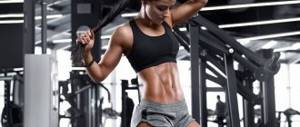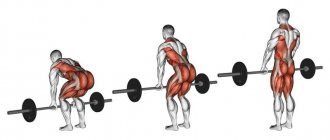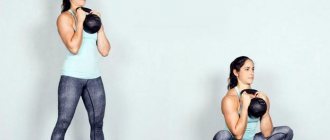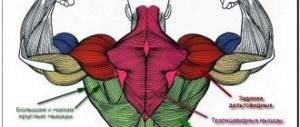Exercise “cat” for the back: features of the program, the best complexes
Skip to content
Website about weight loss
Home » Workouts » Exercises » Cat exercise for the back
02/15/2019 Vladimir Comment
- Execution technique.
- We do it right.
- The benefits of "cats".
How to achieve beautiful posture and get rid of unpleasant pain in the lumbar region? Be sure to include the cat exercise for your back in your personal training program. This is one of the simplest elements, but if performed correctly, you can achieve unprecedented results by improving your body health and working important muscle groups.
If you have been suffering from back pain for a long time and want to improve your posture, start arching and bending correctly.
Features of the “Cat” exercise
It was originally used in yoga. Now quite common in fitness and physical therapy. The peculiarity of the “Cat” or “Dog” exercise (a less common name) is that it can safely and effectively affect the entire body. Firstly, with the help of this exercise you can reduce pain in the back. Secondly, the “Cat” exercise for the spine has a beneficial effect on the functioning of the respiratory system. Therefore, those who often suffer from bronchitis or who have a weakened immune system are also recommended to pay attention to “Kitty”.
Effect on the body
During the training process, the abdominal and back muscles are included in the work, the lumbar and core muscles are trained. The spine is stretched and posture, flexibility of the back, shoulders and neck improves, and coordination also becomes better.
In addition, the abdominal muscles are trained; you won’t be able to pump them up with this exercise, but you can tighten the rectus abdominis muscle. By the way, the best method for a bulging belly is considered to be an exercise - vacuum.
Many people, after regular practice, note a reduction in pain in the lower back.
Muscle work
What muscles are affected when performing a cat?
- The entire group of muscles responsible for straightening the back.
- The muscles that flex the back, namely: the rectus abdominis, external and internal oblique muscles.
The exercise does not require serious physical training, so it will be effective even if you practice on your own. If you are determined to get noticeable results, do not forget about the importance of systematic training.
It is advisable to do cat exercises daily, combining it with exercises for other muscle groups. The time of training does not play a fundamental role, but it is still not recommended to do it immediately after eating. Ideally, 1.5–2 hours should pass between eating and performing the exercise.
You don't need any special equipment for the workout, so you can do it at home. For your comfort, you can use a gymnastics mat or a soft towel to reduce the stress on your knees.
Beneficial properties of the exercise
Of course, when performing any set of exercises, you are primarily interested in the effect it gives. The “Cat” exercise has a number of advantages. Which ones? More about this below.
- Relieves back pain. Those who suffer from pain simply need to do this exercise. Due to the uniform load on the back muscles, which are subject to active movement, pain is reduced.
- Recommended for pregnant women. "Cat" has a double effect. Combining both breathing exercises and healing properties, that is, gradual muscle stretching, the “Cat” exercise for pregnant women is one of the recommended ones.
- The “cat” helps tighten the abs. Along with relieving pain, the exercise has another property that will be very appealing to those who want to have a toned tummy. The fact is that when performing the “Kitty” exercise, a person’s abdominal muscles are always tense. The exercise itself does not require any special body movements. In other words, you can get graceful abs on your stomach without straining.
- Helps relax the spine and neck. So much has been written about the dangers of a sedentary lifestyle, but nevertheless, people are in no hurry to follow doctors’ recommendations and diversify their lives with exercise. But problems in the cervical-vertebral region arise precisely because of this. Performing the “Cat” exercise helps stretch the muscles and ligaments in the neck and back.
- The exercise can be performed by both experienced athletes and beginners. “Kitty” is not a difficult task. It does not require any special devices, so it can be performed in any conditions. Due to this, the exercise is suitable for both athletes and beginner amateurs. The only thing that needs to be observed is to regulate the load in accordance with the characteristics of your body. The “Cat” exercise for children is also recommended.
- Increases the endurance of the body as a whole. Despite the simplicity of the exercise, a huge number of muscle groups are involved in its various variations. The usual pattern applies here: the more parts of the body we use at the same time, the greater the impact. Working together, the muscles exert enormous pressure on the entire body. And so the natural consequence is that his endurance and resilience increases.
- Increasing the speed and quality of metabolic processes. Due to the special technique of performing the exercise, our body is saturated with oxygen. As a result, blood begins to circulate faster, and nutrients reach the necessary organs more quickly.
The benefits of "cat"
If you lead a sedentary lifestyle, “cat” should definitely be included in a set of exercises to develop flexibility, etc. The benefits are enormous:
Note. This movement is especially recommended during pregnancy. It perfectly relieves the lumbar region and effectively massages the abdominal area.
There is nothing difficult in doing the exercise. It copes with its tasks perfectly, while being accessible to people in any physical form.
How to do the exercise correctly?
Take your starting position.
- To do this, you need to get on the mat on all fours.
- Arms should be extended, palms pressed firmly to the floor surface. Fingers point forward.
- Bend your legs at a right angle. Make sure the load is evenly distributed between your knees and palms.
After taking the correct position, you can begin the exercise.
- Exhale deeply while drawing in your stomach. Arch your back upward, lower your head. Try to stretch your back up as high as possible. Make sure your abdominal muscles are tense.
- Remaining in this position, count to eight. After taking a deep breath, slowly return to the starting position. Relax.
- Inhale again. But this time arch your back in the opposite direction. The head should be raised. The pectoral muscles and abdomen are stretched during this process.
- Also, after counting to eight, exhale and return to the starting position.
Repeat the "Cat" exercise for the back 5-10 times. Let's consider another option for performing “Cats” in the classical variation.
To perform the exercise, get on all fours, while leaning on your palms and knees. Lowering your head and pelvis down, arch your lower back upward. Remaining in this position, count to ten. Then lower your pelvis onto your heels. Your arms should remain extended on the floor. Rest your head on your hands, doing an asana, which in yoga is called child's pose. Relax. Do two or three repetitions.
Execution technique
This exercise is very easy to perform. To do this you need to take the correct position:
- We lay out the gymnastic mat and get into the “on all fours” position.
- Place your palms on the surface. In this case, the fingers should point forward.
- We make sure that the body forms the correct geometric figure - the arms are fully straightened, the legs are bent at the knee joint at an angle of 90 degrees.
Have you taken the right position? Let's get straight to the exercise:
- Let's exhale. We twist the pelvic area inward, rounding the back as much as possible and lowering the head down. It is important to tense your abdominal muscles. The back is stretched and in a relaxed state.
- As you inhale, we return to the starting position.
- Then, exhaling, we bend the back in the opposite direction. In this position, the abs are relaxed and the back is tense.
- The exercise ends with the adoption of the original position.
3 more types of this movement
In the world of training, there are also several other varieties of this exercise:
Japanese cat
When performing this type, the legs are also resting on the knees, but are spaced wider. In this case, the hands rest their elbows on the floor. The deflections themselves are performed in the same way. The difference is that in this position the chest area .
Sphinx
This time the pelvis should lie completely on the surface. Hands should be placed, with emphasis on the elbows, in front of you. This way, again, the thoracic region of the body is better loaded. This movement is known from yoga, another name for it is “Cobra”.
The cat moves its tail
The starting position corresponds to the classic one. But, having made an upward bend, you should make wave-like movements to the side with your pelvis, while your shoulders are also in the same direction and move towards one or the other hip.
Such movements have a beneficial effect on the spine.
Flexion
A healthy back can bend vertebra by vertebra.
- Get on all fours.
- Slowly round your back, starting from the lower back, gradually moving to the chest and neck.
- Arch your back back, vertebra by vertebra, starting from the neck and ending in the lower back.
- Repeat five times.
This is a more complex version of crunches, which is suitable for those who can already reach the floor with their hands.
- Stand on a chair or cabinet with your toes on the edge.
- Lower your chin to your chest, then begin to twist the thoracic region, vertebra by vertebra, and then the lumbar region.
- Bend over until you reach full range of motion. Your wrists should be below the edge of the cabinet or chair; do not bend your knees.
- Just as slowly and gradually rise back up.
Start the crunches without weight, just trying to get your wrists as low as possible. Then try doing crunches with a light weight in your hands - 2-8 kg, depending on your physical fitness. Every month, increase the weight in your hands by 1–2 kg.
Tips and tricks for doing the exercise
First, about the general rule. When performing any back exercise, the actions should be smooth. Everything is done at a slow pace. No jerking! The correct position in the exercise is important.
The starting position implies a clear position of the knees parallel to the pelvis, and the palms parallel to the shoulders. The abdominal muscles should be tense throughout the exercise.
- To better arch your back, lift your head as high as possible.
- As you arch and arch your spine, hold the position for about eight to ten seconds.
- When tilting your head down, try to point it as close to your elbows as possible.
- It is best to perform the “Cat” exercise on an empty stomach. You can do it every morning. If you train in the evenings, then wait a few hours after eating and then start exercising.
Recommendations
Exercise is beneficial for everyone. It is ideal for strengthening and unloading the back, as well as for recovering from injuries. Mainly used:
- In strength sports for the development of flexibility, decompression of intervertebral discs.
- Preventing back pain.
- As an effective form of warm-up, prevention and strengthening of spinal health during a sedentary lifestyle.
- During the rehabilitation period after injuries (only when the doctor allows minimal physical activity).
It is recommended to perform the movement as a separate complex for 1-2 minutes. It is optimal to do 1-2 series per day (for example, morning and evening). It is necessary to hold the position in each phase for 5-10 seconds, no more. Prolonged holding without breathing will stimulate additional straining, which can negatively affect the blood vessels. This is especially true in the cow/dog pose, where the head is lower than the heart and blood flow to the brain increases.
Lexical topic “Pets”
Remind your child that we call pets, those animals that live with a person and benefit him, and the person takes care of them. Look at pictures of domestic animals and their babies. Let the child show and name them.
We enrich and activate children's vocabulary with nouns: sheep, ram, lamb, lambs, horse, horse, foal, foals, cow, bull, calf, calves, piglet, piglets, pig, wild boar, goat, goat, kids, kid, dog, dog, puppy, puppies, cat, kitten, kittens, cat, pigsty, cowshed, stable, booth, kennel; torso, belly, head, muzzle, neck, tail, hooves, horns, paws, legs, claws, teeth; shepherd, milkmaid, pig farm, calf house, herd, herd, flock, groom; verbs: run, jump, gallop, climb, sleep, feed, catch, meow, bark, moo, neigh, grunt, chew, bleat, pinch (grass), growls, purrs, gnaws, chews, butts, laps, grooms, feeds; adjectives: useful, domestic, fluffy, devoted, affectionate, horned, playful, soft, strong, fast, kind, evil, stupid, smart, caring, cat, dog, cow, goat, horse, useful, smooth, horned, ferocious, spiteful, stubborn; adverbs: fast, deftly, dangerous, difficult, easy, cold, scary, ahead, behind, slowly, lazy, beautiful, cold, deep, far, close, low, high, up, down, hot.
Common Mistakes
When performing the exercise, you need to listen to your body. With the correct technique, there should be no pain in the neck and spine. If you feel pain, you should stop exercising.
- Jerking is another common mistake. Making sudden movements can cause serious injury to the vertebrae.
- Bent knees and elbows. When performing the exercise, your arms should be straight. And the knees of the legs should form a right angle with the shins.
- When describing the exercise, it is indicated when it is necessary to inhale and exhale. Failure to comply with these rules is also quite common. The fact is that sagging restricts the flow of air from the lungs. So before you do the backbend, take a deep breath.
- No need to throw your head back. First of all, there is no need to do this at all. And secondly, you risk getting a neck injury.
Back extension
This back movement is very important if you want strong muscles that keep your spine straight during weight-bearing exercises. Probably the most popular exercise for strengthening the back extensor muscles is hyperextension.
You can perform this exercise on an incline or horizontal hyperextension machine, a GHD machine, or even on a bench if you have something to grip your legs with.
- Lower your body until it is parallel to the floor. You can cross your arms over your chest, hold them on the sides of your body, or put them behind your head.
- Straighten your back, pull your shoulders back and squeeze your shoulder blades together, pull your chest up. Stay in this position for a couple of seconds and repeat the exercise.
- Perform three sets of 15–30 repetitions depending on your training.
Switching loads in basic fitness for show dogs
- Trot with obstacles (using cavaletti).
- Walking backwards. You might be surprised, but most dogs can't walk backwards. The dog should walk straight, without leaning to one side or the other. The dog must take at least 10 steps with each paw. First, you can create a small narrow corridor (for example, on one side there is a wall, on the other there is some kind of obstacle).
- Jumping up. This is done as slowly as possible, but so that the dog has jumped onto some surface, you turn it around its axis, and it carefully jumps off (if the dog is small, it is better to lower it in your arms).











